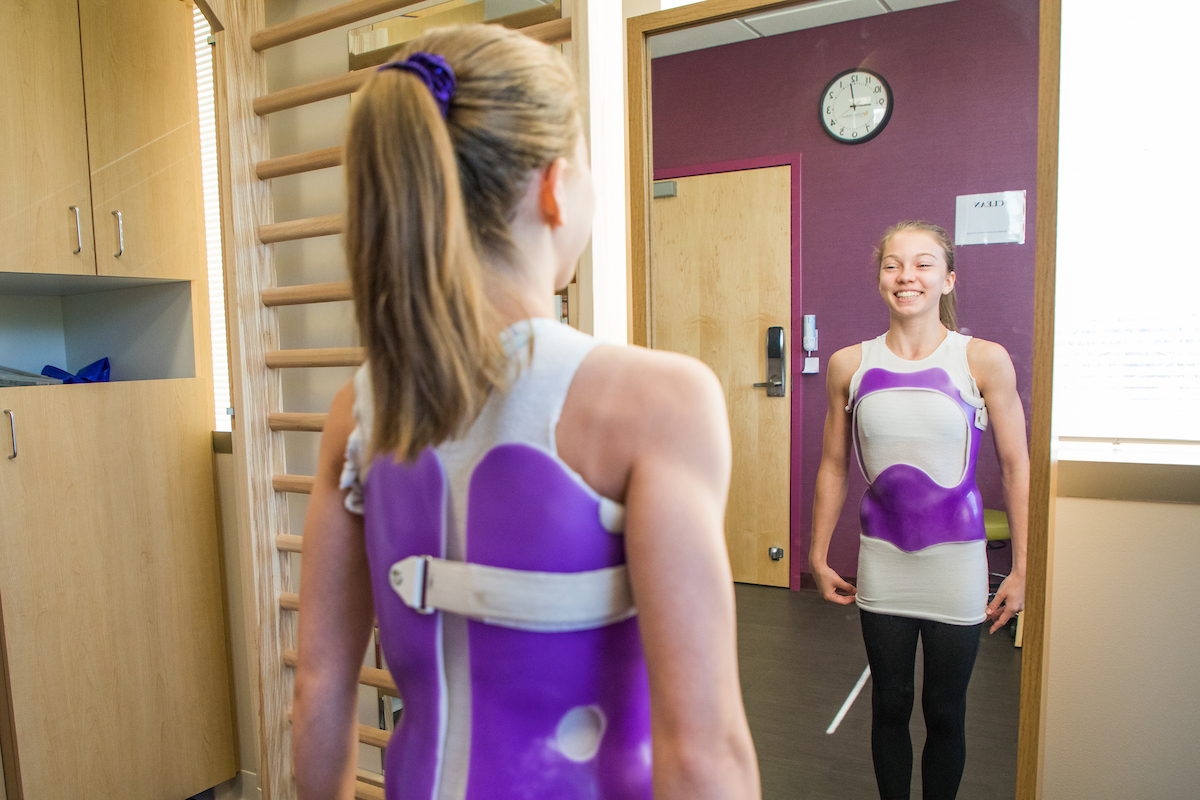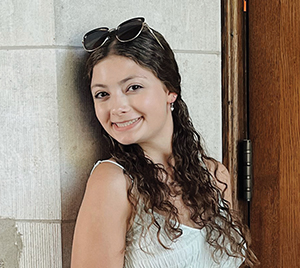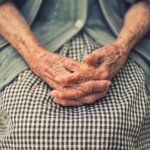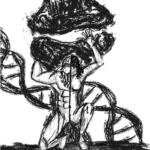How to address the psychological impact of scoliosis bracing

Answering Common Questions About Scoliosis Bracing for Kids and Teens. Gillette Children’s, Foster Brennan.
by Maria St. Louis-Sanchez, The O&P Edge May 1, 2023
Megan Glahn Castille, MS, CPO/L, was in an O&P class when she first learned about bracing for scoliosis. “I remember hearing about how they are expected to wear their braces for 23 hours a day and then, click, we went to the next slide,” says Castille, who is also an assistant professor at Baylor College of Medicine, Texas.
Her teacher was focused on the biomechanics of the brace, but even as a student, Castille realized the importance of another aspect of treating scoliosis: the psychological side of bracing.
Castille was a gymnastics coach throughout high school and college. She pictured the bracing experience through the lens of the young gymnasts. Scoliosis tends to strike during the awkwardness of adolescence when girls are at the height of self-consciousness and peer approval means everything. She thought about what it would mean for the gymnasts she coached to be at that stage of life and then be told to continually wear a brace that would make them stand out from everyone else.]
“It made me think twice about our primarily female patients who are expected to go about their normal lives while being wrapped in a piece of plastic for 23 hours a day,” she says.
Soon enough, Castille focused her orthotic specialty on treating scoliosis and her academic career on studying the psychological toll that scoliosis can have on patients. The more she learned, the more she realized how critical it was to ensure that scoliosis patients are mentally prepared and have the support they need to get through the trials of bracing unscathed.
She says this mental fortitude helps with brace compliance, thus producing better outcomes, but also helps stave off a potentially dangerous mental toll that scoliosis can trigger.
Studies show that adolescents with scoliosis are 40 percent more likely to develop suicidal ideations.[1] What’s more, 32 percent of adolescents with scoliosis have been shown to have clinically significant psychological symptoms and have a “less positive outlook on life, suffer from lower self-esteem, and have more difficulty connecting with peers.” That level of anxiety is equivalent to that of childhood cancer and pediatric diabetes patients.[2]
Kara Davis, CPO, clinical coordinator at Scottish Rite for Children, Texas, has seen the stress that scoliosis bracing can inflict on her own patients.
She says that orthotists, who see their scoliosis patients regularly, are in a unique position to monitor the stress and anxiety levels of their patients. By keeping an eye out for their psychological well-being, Davis says orthotists can help their patients stay mentally strong while being successful in bracing. “To treat the back, you have to treat the head.”
| The Benefits and Challenges of Bracing |
To the experts, the evidence on bracing for scoliosis is clear: Bracing works and the more adherent to bracing the patient is, the better the outcome will be. The 2013 Bracing in Adolescent Idiopathic Scoliosis Trial showed the effectiveness of wear time and success. In the bracing group, 90 percent of those who wore their brace for 13 or more hours per day avoided surgery. Bracing was found to be so effective that the study was forced to stop early because it was considered unethical for the observation-only group to be kept from wearing a brace.[3]
“Bracing is extremely important,” says Christina Gambrell, CPO, Scottish Rite. “It’s the only documented method outside of surgery proven to have any positive effect on slowing the progression of scoliosis.”
The challenge, however, is convincing a mostly adolescent female patient population to wear a brace for the majority of their time. The adolescent body, going through regular growth spurts, has a limited amount of time for bracing to be the most effective. Unfortunately, that is the exact same time of life when the mind is going through some of its most turbulent years.
“It’s terrible timing,” Davis says. “Their bodies and hormones and everything is changing, and then you throw—we throw—a brace on top of it.”
When most patients need a brace is also around the time in their lives when they are becoming their own person and moving toward independence, says Castille.
“Then this gets thrown at them, and that march toward independence gets halted,” she says. “They need rides to their appointments and sometimes need help putting on the brace.”
Bracing is shown to be most beneficial during the few years when patients are growing the most, says Joshua Utay, EdD, CPO, an orthotist at Scottish Rite. But convincing patients to make the most out of this finite amount of time can be difficult for them to comprehend.
“It’s short-term work for long-term gain, and that’s not how the adolescent brain works,” he says. “We’re asking them to reach out of their comfort zone and trying to get them to understand something that most of us don’t process until we’re in our 20s: There is no later. There is only now.”
All these issues mean patients may be resistant to wearing their braces as often as they need for the braces to be effective. Even if an orthotist makes the best brace, it’s not useful unless it’s worn, says Scott Thach, MSPO, CPO/L, Children’s Healthcare of Atlanta. He says it’s the job of the orthotist to go beyond making the brace and to work to truly understand what’s happening mentally with their patients.
“Just asking how you are doing and obtaining automatic responses of ‘okay’ or ‘fine’ is not sufficient for our patients with scoliosis,” he says. “We may not necessarily be comfortable asking how they are really doing.”
He says he uses a Feelings Wheel for his older patients and an Emoji Feelings Chart for his younger patients.
“This allows them to really consider their feelings as well and opens the door for more conversation as to why a patient may be feeling a certain way other than just okay or fine,” he says.
From there, he says, orthotists can help spot any issues that may exist and, if needed, refer the patient to resources for additional help.
Experts have a range of strategies for trying to gauge the mental health of their patients.
Christopher Nelson, CPO, clinical director at Children’s Hospital of Philadelphia, says he tries to read nonverbal cues when he meets his patients.
“I read their body language,” he says. “You don’t always get verbal or written information that tells you what is going on. Some people are less comfortable, and you have to change your approach based on how they are feeling.”
The diagnosis and brace can sometimes be traumatic, he says.
“Some are crying, some are angry,” Nelson says. “You have to sort of let them be upset.”
What helps, he says, is talking to them a lot so they understand their diagnosis and helping them to feel as if they have at least some control of the situation, he says.
“The more involved they are in the process, the easier it is for them to get over it.”
| Getting Patients on Board With Bracing |
Even the most observant parents can’t watch every second to ensure their children are wearing their braces as often as they should. That kind of watchfulness isn’t helpful anyway, Nelson says.
“There’s a fine line between being supportive and being stern,” he says. He compared it to parents with children in athletics who scar their children by pushing too hard in an attempt to make them the best at their sport.
“The balance comes from educating the kids and letting them be a part of the process,” he says.
The experts say that when patients are on board with bracing, they wear their braces more frequently and struggle less with the mental toll it can have.
Thach says he has shifted his approach in bracing from the idea of brace compliance to adherence.
“Compliance is passive, a more just ‘do as I say’ approach,” he says. “By switching to adherence, we discuss and formulate a plan together so that patients are successful in making a schedule they will be more likely to follow.”
Giving the patients power in the process can be invaluable, the experts say. Many offices allow patients to choose the design on the outside of their braces. Davis encourages her younger patients to give their braces a name and make it a part of them.
Castille says she helps her patients come up with an action plan so they know how they will react to certain situations. For instance, she helps them figure out a script of what to say when other students ask them about their braces.
“I don’t want them caught off guard when someone sees the brace and asks them what it is,” she says. “I have them explain to me how they plan to explain it to someone else.”
Another way to empower her patients is through education, says Castille. She developed the Scolios-us website (bracingforscoliosus.org) not only to support her patients but also to help fellow healthcare providers address the psychological side of scoliosis. Patients can learn about the importance of bracing and learn tips and tricks to wearing fashionable clothes while in a brace. Clinicians can see a variety of resources for patients and learn about the latest research. The site is also a resource to connect scoliosis patients with peer mentors who have been through bracing. Scottish Rite also has a patient website with educational and peer connection resources. Davis says their braces have a sticker with QR code that will link them to the site.
“We just wanted all of our patients to be aware of all of the resources out there,” Davis says.
‘For instance, if a physician prescribes a brace to be worn 18-20 hours per day, I like to focus on the four to six hours out of the brace every day. I use the term ‘pick your six,’ which I heard from one of our child life specialists. This seems to lessen the stress of getting hours in.
| Peer Support |
During adolescence, the support and acceptance of peers can be crucial, the experts say. That desire for acceptance can be detrimental when scoliosis patients, who may be scared and unsure of themselves, hide their braces from the friends who might be able to offer the most support.
“Patients who tell their friends about their brace and feel emotionally supported by their friends had better mental health scores in our most recent study,” says Castille. “But we found that only about 50 percent of our patients were telling their friends. You can imagine what holding onto a secret like that would do.”
She encourages her patients to get their friends together at a sleepover and have them try on the brace.
“It gives the friends a good perspective about what they are going through,” Castille says.
The experts say that peer support from mentors who have been through scoliosis can also be helpful. These mentors are great for patients who might not have a strong friend support group or for those who want to talk to someone who can be a sounding board for what they are going through.
“Hearing it from a peer who is doing it and doing it successfully is super helpful,” says Davis.
Martinson says she tries to match peers who have similar ages and experiences.
“A six-year-old boy is going to have a vastly different set of concerns and issues than a 13-year-old girl,” she says.
Sun Hae (Sunny) Jang, PhD, CO, FAAOP, Eastern Michigan University, says when she worked at a scoliosis clinic, she and her colleagues tried to get their patients together in a fun and comfortable setting. On top of matching them with peer mentors, they hosted events to bring the patients and their families in to listen to any issues they had and give their suggestions. They also organized a fashion show for patients.
“Girls shared their clothing tips when wearing their orthosis with each other,” says Jang, who is also an associate professor for the orthotics-prosthetics master’s program at the university.
| When Bracing Is too Much |
Since bracing for scoliosis can have such a psychological impact on the patients, there are some that are unable to mentally cope with it. Perhaps they have other mental health issues or other stressful aspects of their lives that their medical team may or may not have knowledge of.
Davis says that when she sees potential issues, she will utilize the help of child life specialists or psychologists.
“There are some that we do try to refer them for more help,” she says. “A lot of times there is something else going on, whether it be bullies at school or tension at home.”
The situation may even escalate enough that the medical team has to decide whether bracing is doing more harm than good, Nelson says.
“Sometimes bracing won’t work for some people,” Nelson says. “I can make the brace fit really well, but if the patient just emotionally can’t deal with it, then it can be counterproductive…. You can have kids who have long-term psychological impacts from being forced too much.”
Utay has had a few of these patients as well. “Sometimes what’s going on in their lives is already so stressful that wearing this brace a meaningful amount of time is just not going to happen,” he says. “Thankfully that’s a minority of patients.”
For these patients, he stays in touch, monitors their spinal curves, and tries to be as encouraging as possible whenever he can.
“We want to continue to see them,” Utay says. “We don’t want to alienate anyone. We will encourage them to make follow-up appointments.”
Gambrell says that if the bracing is causing too much strife, negatively impacting parent and child relationships, or causing serious anxiety, then the physician will have a discussion with the patient and family. They can decide together whether it is worth it to continue with the brace, she says,
“No one is made to feel guilty for choosing to stop wearing a brace,” she says. “We want it to be an informed, intentional decision discussed as a group, so everyone is on the same page and no one feels bad about it later.”
| Q&A With Scoliosis-us Patient Mentors |
| Kate Kennedy, 12 years old |
 Kate was diagnosed with scoliosis when she was eight years old and wore a brace beginning at age ten for 18-20 hours a day. Her curve kept progressing however, and she underwent vertebral body tethering surgery in August 2022.
Kate was diagnosed with scoliosis when she was eight years old and wore a brace beginning at age ten for 18-20 hours a day. Her curve kept progressing however, and she underwent vertebral body tethering surgery in August 2022.
After your diagnosis, your medical care team referred to a mentor who had a similar experience. What was that like?
I really liked connecting with someone who really understood fully what I was going through. Even though scoliosis is not super uncommon, you can feel like there isn’t anyone else in the world who understands.
What was the hardest part about wearing a brace?
I used to get really stressed about not getting enough hours. I was sure that I’d have to get surgery if I didn’t wear it 18-20 hours a day, and I would get worried about it and feel as if I wasn’t good enough if I didn’t get enough hours. When I found out I needed surgery, I was in disbelief. I was really doing really good and I was frustrated. It was like I did all of this, and I still got the outcome I was trying to prevent.
How are you doing post-surgery?
“I do not regret getting surgery at all. It was either that or I’d have to wear my brace for two more years and then maybe get spinal fusion surgery anyway. I love being out of a brace. I used to always have it on the back of my mind, and it’s refreshing not to have to think about it. Surgery was tough, but it was a one-and-done thing and hopefully, there will be no more bracing in my future.”
| Molly Karp, 15 years old |
 Molly was 12 years old, and the pandemic had just started, when she was diagnosed with scoliosis. She was bracing for 16 hours a day for about three years and has been night bracing for the past few months. She has been told that she should be out of the brace in about a year.What was your reaction to your diagnosis?
Molly was 12 years old, and the pandemic had just started, when she was diagnosed with scoliosis. She was bracing for 16 hours a day for about three years and has been night bracing for the past few months. She has been told that she should be out of the brace in about a year.What was your reaction to your diagnosis?
“It was definitely a shock and scary. All I knew was I had to work hard to wear my brace, so it didn’t become even harder on me. “
What was your reaction when you found out how long you were expected to wear the brace?
“I was really scared, and it really stressed me out counting the hours. I felt that if I didn’t reach the amount of time I needed, I kind of failed for the day. It put a lot of stress on me.”
Was there anything you worried about but then it didn’t turn out to be a big deal?
I was worried at first about how my friends would look at me. It was really nerve-racking, but they have been so supportive and nice about it.”
| Caitlyn Todd, 15 years old |
 Caitlyn was first diagnosed with scoliosis when she was two years old and being treated for an unrelated condition. She wore a brace from ages three to seven and then started wearing it again at 11 years old. When she was first diagnosed, her curve was 30 degrees and it has since progressed to 46 degrees. She underwent spinal fusion surgery in April.
Caitlyn was first diagnosed with scoliosis when she was two years old and being treated for an unrelated condition. She wore a brace from ages three to seven and then started wearing it again at 11 years old. When she was first diagnosed, her curve was 30 degrees and it has since progressed to 46 degrees. She underwent spinal fusion surgery in April.
What did you think when you began wearing a brace again at 11?
“When I first saw myself in the brace, I immediately began to have flashbacks from when I was younger…. I was also stuck with nerves about wearing the brace in a middle school environment and thought about the adjustments I would have to make in my life once again. It was almost as if I was grieving for the younger version of myself who thought this was all over.”
What was the hardest part about wearing the brace?
“The hardest thing about wearing my brace was the fact that I was a middle schooler surrounded by not-so-nice kids my age. I was always thinking about what other people thought of me, which ranged from wondering if the person behind me noticed the brace sticking out to having to change the way I picked up my pencil so there was no indication I had plastic underneath my clothes.
What was the reaction from your peers?
“When I was 11, I remember immediately telling my three close friends at the time. Each of them gave me a hug, asked questions, and empathized with me from the little information they understood. Looking back, I find that really special because it helped me to feel more accepted in school knowing that I wasn’t the only one who understood what I was going through.”
| Samantha Neer, 16 years old |
 Samantha was diagnosed with scoliosis at age 13, and it was already considered moderately severe. Last June, she had a growth spurt and the curve increased to 50 degrees. She later underwent spinal fusion surgery and is now doing well.
Samantha was diagnosed with scoliosis at age 13, and it was already considered moderately severe. Last June, she had a growth spurt and the curve increased to 50 degrees. She later underwent spinal fusion surgery and is now doing well.
What was your reaction to your diagnosis?
“I was very surprised. At every other physical, my pediatrician said I had a slight curve, and it was nothing to worry about. But at my 13-year-old appointment, she said it was not slight anymore. When I got an x-ray and found out that my curve was already 42 degrees, I was definitely upset.”
What was going through your mind when you began wearing a brace?
“When I first saw myself in the brace, I felt ugly and not myself.”
What was your reaction when you found out how long you were expected to wear the brace?
“At first, I was told that I would need to wear a brace for at least a year, for 23 hours a day. I was very disappointed that I’d have to wear it all day, every day, for a year, but I was even more disappointed when my curve didn’t improve at all, and I had to wear it for another year.”
| Maria St. Louis-Sanchez can be contacted at msantray@yahoo.com |
Source The O&P Edge
| References |
- Does scoliosis have a psychological impact and does gender make a difference? Payne WK 3rd, Ogilvie JW, Resnick MD, Kane RL, Transfeldt EE, Blum RW. Spine (Phila Pa 1976). 1997 Jun 15;22(12):1380-4. doi: 10.1097/00007632-199706150-00017.
- Clinically Significant Psychological and Emotional Distress in 32% of Adolescent Idiopathic Scoliosis Patients, Sanders AE, Andras LM, Iantorno SE, Hamilton A, Choi PD, Skaggs DL. Spine Deform. 2018 Jul-Aug;6(4):435-440. doi: 10.1016/j.jspd.2017.12.014.
- Effects of bracing in adolescents with idiopathic scoliosis, Weinstein SL, Dolan LA, Wright JG, Dobbs MB. N Engl J Med. 2013 Oct 17;369(16):1512-21. doi: 10.1056/NEJMoa1307337. Epub 2013 Sep 19. Full text, PDF
Also see
Bracing the Curve The O&P Edge
Five-year Case Study of an Infant With Scoliosis Using Schroth Therapy and Chêneau-type Bracing The O&P Edge
Adolescent Idiopathic Scoliosis: Helping Kids Meet the Compliance Challenge The O&P Edge
Academy Society Spotlight: Influencing Compliance in Adolescent Idiopathic Scoliosis The O&P Edge
Answering Common Questions About Scoliosis Bracing for Kids and Teens Gillette Children’s
Study Affirms Benefit of Back Braces as Scoliosis Treatment The New York Times
☞ Bracing prevents need for surgery in teens with scoliosis






